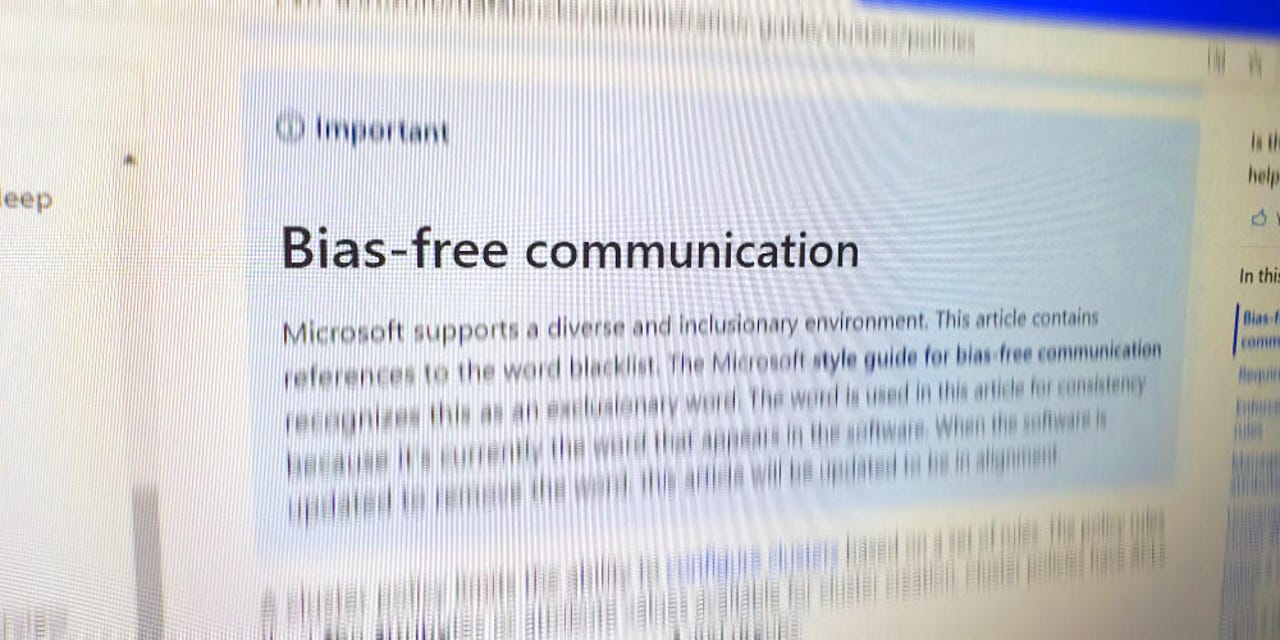IBM, Microsoft staff rally to remove racially insensitive language from products

Although public attention has been shifting away from the Black Lives Matter protests and the issues of racial inequality, efforts are still underway at many companies to clean up their tech jargon and replace racially insensitive and biased language.
After efforts at Twitter, GitHub, Red Hat, MySQL, the Linux kernel, and OpenBSD teams have made public headlines, ZDNet has learned of similar efforts also taking place inside two of today's biggest tech companies -- IBM and Microsoft.
Employees have come together at each of the two companies and created informal groups with plans to scour documentation and source code to replace insensitive terms with neutral and more socially acceptable alternative terminology.
These efforts, while not publicly advertised like similar endeavors at other companies, are just as important, if not more, as IBM and Microsoft manage some of today's largest software repositories, with millions of lines of code spread across portfolios spanning hundreds of products and open source projects.
Nobody at IBM and Microsoft is so naive to believe their efforts will eradicate racism just by changing a few words inside code here and there, but everyone is trying to play their small role towards a more inclusive society, for all, in the long run.
IBM's top-down approach
But the efforts, while similar in their goal, are different at the two major tech behemoths. While Microsoft staff have started as a self-action group inside the company, things at IBM begun from the top, with management's blessing.
Big Blue, as IBM is sometimes lovingly called in the tech community, has taken a coordinated approach, Tim Humphrey, VP and chief data officer at IBM, told ZDNet in a phone call this week.
Humphrey says the company has established a group inside its Academy of Technology (AoT), an internal organization that IBM describes as "an action-oriented society of IBM's leading thinkers and problem solvers" that provides "technical leadership linking IBM technical communities."
This group is currently in the process of reviewing around 15 technical terms and looking for appropriate alternatives. The list currently includes obvious terms like master, slave, blacklist, and whitelist, but also terms like white label, white paper, man-hours, or Chinese walls.
Terms don't necessarily have to be racially charged, and xenophobic and gender-biased languaged will also be up for review, Humphrey said.
Furthermore, the entire process is open, and IBM employees can submit any other words they think shouldn't be in the company's documentation or source code.
Humphrey says that some of the terms have already been removed from the company's internal style guide, a document that governs acceptable language inside IBM. This style guide is at the heart of all IBM public communications, documentation files, and source code projects.
Currently, IBM staffers are in the process of removing biased language from the company's code and docs in what Humphrey has described as an "exhaustive cleanse."
And all of this is done by an "army of volunteers" of IBM employees who are dedicating their free time toward a higher goal.
Microsoft's informal group
At Microsoft, similar efforts are also underway. However, this initiative isn't actually new, and, in fact, started many years before. What's different now is the scale, with more employees volunteering their free time than before.
These efforts started after the Ferguson riots, when a handful of employees set up an internal group and started reviewing the company's source code, along with its internal and external documentation, for biased language, to replace it with more inclusive terminology.
Terms like whitelist and blacklist were switched with allowlist and denylist, and master-slave with primary-secondary, where appropriate.
If source code couldn't be changed due to legacy reasons or integrations with third-party code, warnings have been added to public documentation pages that the docs include language that some might consider offensive or non-inclusive.
Some of the warnings about bias and non-inclusive language that are currently being showed on some Microsoft documentation pages.
What started as a handful of people working on reviewing Microsoft code and docs a few years back has turned into a 50+ group in July.
And while working without explicit approval or direct supervision from Microsoft top brass, such efforts have not only been tolerated but also broadly adopted inside Microsoft's known progressive environment, with the LinkedIn team engaging in similar efforts as well.
All in all, the movement to clean up tech terminology that got underway after George Floyd's death earlier this year, and which many have described as misplaced virtue signaling, has slowly turned into one of this year's major industry trends. The fruits of this labor may take a while to show up in the way engineers speak and write their code, but Humphrey, IBM, Microsoft, and their employees are more than aware that what they're doing is laying the groundwork in a multi-year project.
